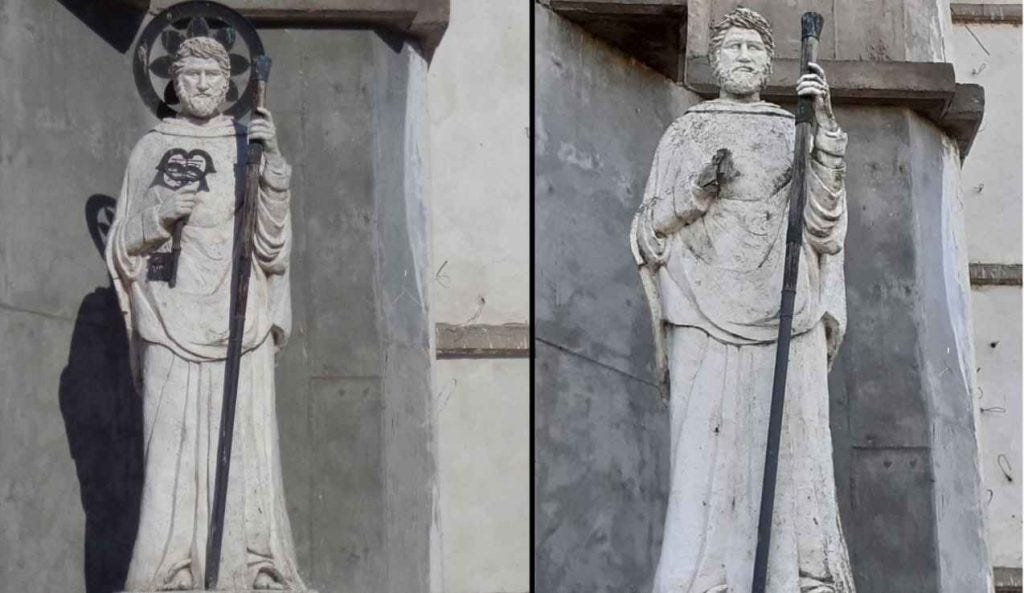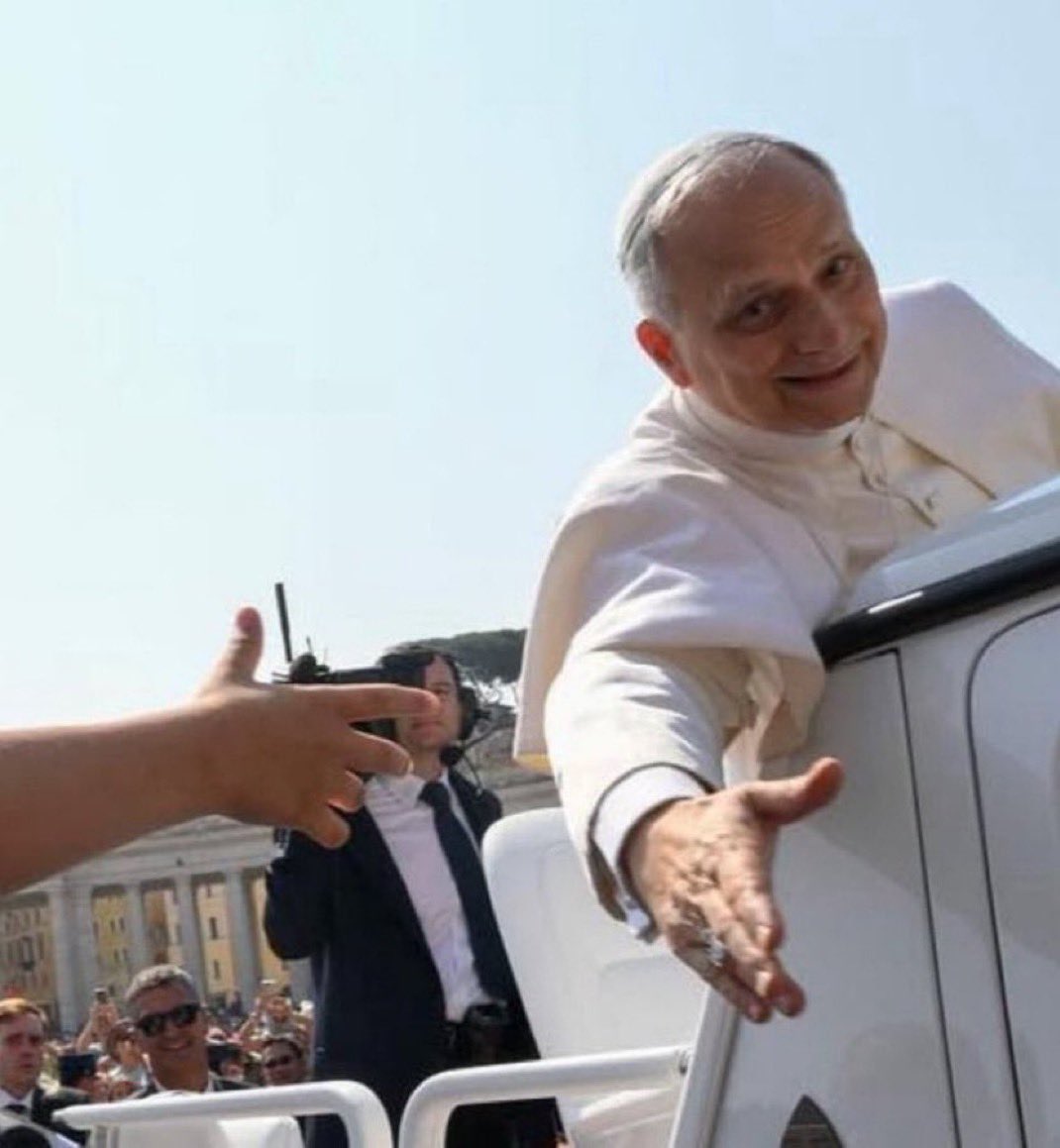Heralding the end of Bergoglio’s reign?
Real or Fake? Lightning Reportedly Maims Statue of St. Peter in Buenos Aires

The internet is abuzz right now with a report by Resignationist Andrea Cionci, author of The Ratzinger Code (debunked by a Francis adherent here), saying that a statue of St. Peter on the façade of the Sanctuary of Our Lady of the Rosary of St. Nicholas in the province of Buenos Aires, Argentina, was zapped by lightning on Dec. 17 which made its halo and right hand fall off, along with the key it was holding (by which is symbolized the key to the kingdom of heaven; cf. Mt 16:19):
- “Buenos Aires: lightning on the halo and keys of St. Peter. Bergoglio at the end of the road?” (Pope Head Post)
Cionci has released a video report about it as well (in Italian).
A before-and-after photo is making the rounds now (see image above), though some are questioning the authenticity of this story and/or photo. However, in his article Cionci says the incident has been confirmed by one Rev. Justo Lofeudo and by clergy of the shrine.
The lightning strike reportedly happened on Dec. 17, 2023, which was Francis’ 87th birthday, and it was one day before the release of Fiducia Supplicans, Bergoglio’s infernal declaration allowing for the blessing of sodomite couples. An astute observer pointed out on social media that it is the right hand that is used for blessings, and it is the right hand of the statue of St. Peter that has now been pulverized.
The Sanctuary is located in San Nicolás de Los Arroyos, which belongs to the province of Buenos Aires but is over 100 miles northwest of the city of Buenos Aires. The statue of St. Peter is located to the right of the main entrance, as can clearly be seen in this 2018 photo.
To help evaluate this alleged incident, let’s recall a few historical facts.
Jorge Bergoglio’s claim to the Papacy (as ‘Pope Francis’) began on Mar. 13, 2013. It could not have happened without ‘Pope’ Benedict XVI (Joseph Ratzinger) vacating the position first, which he did on Feb. 28 at 8:00 pm local time, the moment his pre-announced resignation became effective.
Despite all theories that Ratzinger’s resignation was defective and therefore invalid, either deliberately so or by accident, let us recall that he stated officially that he was resigning “in such a way, that as from 28 February 2013, at 20:00 hours, the See of Rome, the See of Saint Peter, will be vacant and a Conclave to elect the new Supreme Pontiff will have to be convoked by those whose competence it is” (Benedict XVI, Declaratio of Feb. 11, 2023).
What is most important to understand, however, is that Benedict XVI could not possibly have obtained the Papacy to begin with in 2005, hence he had nothing from which to resign:
So it was on Feb. 11, 2013, that Benedict XVI had declared his intention to resign, and many will remember that it was on this day, later at night, that lightning struck the dome of St. Peter’s Basilica, not once but twice:
Fast forward to the present. Apparently another lightning strike has hit, and this time it was a statue of St. Peter in or near Bergoglio’s old stomping ground.
“When God says you’re not the pope”, one Twitter user commented, hopefully (but not necessarily) tongue in cheek:
When God says you're not the pope. pic.twitter.com/DYAWrWKahk
— Fred Simon (@FredSimonTLM) December 28, 2023
No, Fred Simon. Lightning striking a statue of St. Peter, leaving it damaged, in the province of Buenos Aires, that is not how God lets the world know that Bergoglio in Rome is not the Pope. Do you want to know how God lets us know the apostate Bergoglio is not the Pope? Well, here is a small selection:
- Francis: The Different Religions are an ‘Enrichment’ for Humanity
- Francis at Interreligious Congress: ‘Man is the Way for All Religions’
- ‘Herald the Dance of Balance and Harmony’: Francis Signs Crazy Interfaith Climate Statement
- ‘Paradigm Shift’: Francis Issues Disastrous Motu Proprio Aimed at Theological Revolution
- Building Paradise on Earth: Francis’ Message for World Day of Migrants
- Masonic Fraternity instead of Jesus Christ: Francis’ Message for World Day of Peace Fails to Surprise
- Francis to Muslim Elders: ‘Transcendence and Fraternity Alone will Save Us’
- Naturalize to Neutralize: How Francis slyly deprives the Gospel of its Supernatural Character
- Apostate adrift: Francis says Fraternity is “Anchor of Salvation for Humanity”
- Indifferentism for Kids: Francis endorses interreligious “Park of Encounter” in Argentina
- Apostate Bergoglio endorses World’s Religions as “Different Ways of Coming to God”
- Francis expands the “People of God”: Now it includes All Religions!
- Welcome to the Religion of Fraternity: Francis releases dangerous new “Pope Video”
- The Apostate Abu Dhabi Declaration on Human Fraternity
- Naturalism at Full Blast: Francis on the Existence of All Religions
THAT is how we know Francis is not the Pope: because he habitually does things the divine assistance for the Papacy would prevent a true Pope from doing — things that, if they were being done by a true Pope, would utterly destroy and render meaningless (nay dangerous!) the institution of the Papacy.
What divine assistance, you might wonder? The one spoken about in countless magisterial pronouncements on the Papacy:
As Pope Pius XI taught:
…[I]n order that no falsification or corruption of the divine law but a true genuine knowledge of it may enlighten the minds of men and guide their conduct, it is necessary that a filial and humble obedience towards the Church should be combined with devotedness to God and the desire of submitting to Him. For Christ Himself made the Church the teacher of truth in those things also which concern the right regulation of moral conduct, even though some knowledge of the same is not beyond human reason. …[God] has constituted the Church the guardian and the teacher of the whole of the truth concerning religion and moral conduct; to her therefore should the faithful show obedience and subject their minds and hearts so as to be kept unharmed and free from error and moral corruption, and so that they shall not deprive themselves of that assistance given by God with such liberal bounty,fthey ought to show this due obedience not only when the Church defines something with solemn judgment, but also, in proper proportion, when by the constitutions and decrees of the Holy See, opinions are prescribed and condemned as dangerous or distorted.
Wherefore, let the faithful also be on their guard against the overrated independence of private judgment and that false autonomy of human reason. For it is quite foreign to everyone bearing the name of a Christian to trust his own mental powers with such pride as to agree only with those things which he can examine from their inner nature, and to imagine that the Church, sent by God to teach and guide all nations, is not conversant with present affairs and circumstances; or even that they must obey only in those matters which she has decreed by solemn definition as though her other decisions might be presumed to be false or putting forward insufficient motive for truth and honesty. Quite to the contrary, a characteristic of all true followers of Christ, lettered or unlettered, is to suffer themselves to be guided and led in all things that touch upon faith or morals by the Holy Church of God through its Supreme Pastor the Roman Pontiff, who is himself guided by Jesus Christ Our Lord.
(Pope Pius XI, Encyclical Casti Connubii, nn. 103-104; underlining added.)
And no, Francis’ presence in the Vatican is not simply a matter of having a ‘bad’ Pope, as the Church had a few times in the past:
So, is the alleged lightning strike on the statue of St. Peter near Buenos Aires a sign from heaven announcing the end of ‘Pope’ Francis’ reign of error? Let’s be honest: Nobody knows. Perhaps it is; perhaps it isn’t.
The most important point, though, is this: It really doesn’t matter. Anyone who, especially at this stage, is looking for a lightning bolt to tell him if the man who has promulgated heaps of blasphemy, impiety, scandal, heresy, error, and sacrilege in his official magisterium is in fact the Vicar of Christ who keeps the gates of hell from prevailing, has not understood what the Papacy is or how Catholicism works.
Oh well. If nothing else, this lightning story is at least one thing: thoroughly amusing.
Image source: popehead.substack.com
License: fair use





No Comments
Be the first to start a conversation